


CH-47 Chinook
The CH-47 is a twin-engine, tandem rotor helicopter designed for transportation of cargo, troops, and weapons during day, night, visual, and instrument conditions. The aircraft fuselage is approximately 50 feet long. With a 60-foot rotor span, on each rotor system, the effective length of a CH-47 (with blades turning) is approximately 100 feet from the most forward point of the forward rotor to the most rearward point on the aft rotor.
Maximum airspeed is 170 knots with a normal cruise speed of 130 knots. However, speed for any mission will vary greatly depending on load configuration (internal or external), time of day, or weather conditions.
The minimum crew for tactical operations is four, two pilots, one flight engineer, and one crew chief. For more complex missions, such as NVG operations and air assaults, commanders may consider using five crew members and add one additional crew chief.
Development of the medium lift Boeing Vertol (models 114 and 414) CH-47 Series Chinook began in 1956. Since then the effectiveness of the Chinook has been continually upgraded by successive product improvements, the CH-47A, CH-47B, CH-47C, and CH-47D. The amount of load a cargo helicopter can carry depends on the model, the fuel on board, the distance to be flown, and atmospheric conditions.
The CH-47A, first delivered for use in Vietnam in 1962, is a tandem-rotor medium transport helicopter. The Chinook's primary mission is moving artillery, ammunition, personnel, amd supplies on the battlefield. It also performs rescue, aeromedical, parachuting, aircraft recovery and special operations missions. On June 25, 1958 the Army issued an invitation for a General Management Proposal for the US Army Medium Transport Helicopter. Five aircraft selected Vertol to produce the YCH-1B as the Army�s new medium transport helicopter. In July 1962 DoD redesignated all U.S. military aircraft and the HC-1B was redesignated the as the CH-47A. Early production CH-47A�s operated with the 11th Air Assault Division during 1963 and in October of that year the aircraft was formally designated as the Army�s standard medium transport helicopter. In June 1965 the 11th Air Assault Division was redesignated as the 1st Cavalry Division (Airmobile) and readied for deployment to Viet Nam. Chinooks from the 11th Air Assault formed the nucleus of the 228th Assault Helicopter Battalion which began operations in Viet Nam in September, 1965. CH-47A�s deployed to Viet Nam were equipped with Lycoming T55-L7 engines generating 2650 shp. The aircraft had a maximum gross weight of 33,000 pounds allowing for a maximum payload of approximately 10,000 pounds. The hot mountainous conditions of Viet Nam limited the A models performance capabilities and generated a requirement for increased payload and better performance.
The CH-47B was introduced by Boeing after a production run of over 350 CH-47A�s . The B model introduced the Lycoming T55-L7C engine, a beefed up airframe. Nonsymmetrical rotor blades, and the blunted aft pylon for better stability. Boeing began delivering the CH-47B in May of 1967 and eventually produced a total of 108 B models before production shifted to the CH-47C.
The CH-47C Chinook model has a maximum cargo hook capacity of 20,000 pounds. The CH-47C has only a single cargo hook below the center of the aircraft. When hooking a single load, soldiers use the main hook. They must coordinate closely with the aircrew as to which hooks to use when carrying multiple loads. The planning figure for the fore and aft hooks is 10,000 pounds each. The Army�s continued need for further performance improvements lead to the development of the CH-47C. Designed to meet an Army requirement to transport a 15,000 pound sling load over a 30 mile radius, the C model boasted an increased gross weight to 46,000 pounds, increased fuel capacity, the Lycoming T55-L11 engine developing 3750 shp, and addition structural improvements. The first C model flew in late 1967 and became the mainstay of the Chinook fleet until the advent of the CH-47D. Production of the C model continued until 1980 with improvements such as the crash worthy fuel system and fiberglass rotor blades being incorporated into the fleet.
The CH-47D was the result of June 1976 contract for a modernized Chinook. The Army recognized that that the Chinook fleet was rapidly reaching the end of its useful life and signed a contract with Boeing to significantly improve and update the CH-47. Three airframes, CH-47A, CH-47B, and a CH-47C, were stripped down to their basic airframes and then rebuilt with improved systems to provide three CH-47D prototypes. Improvements included upgraded power plants, rotor transmissions, integral lubrication and cooling for the transmission systems, and fiberglass rotor blades. Other improvements included a redesigned cockpit to reduce pilot workload, redundant and improved electrical systems, modularized hydraulic systems, an advanced flight control system, and improved avionics. The Chinook has two tandem three-bladed counter-rotating fiberglass rotors. The CH-47D is powered by two Allied Signal Engines T55-L-712 3750 shp turboshaft engines and has a maximun speed of 163 mph (142 knots). The CH-47D was rolled-out in March 1979. The CH-47D carrys twice the load of a CH-47A and has improved performance. The CH-47D can operate at night and in nearly all weather conditions. The CH-47D is equipped with an air-to-air refueling probe. The Chinook can accommodate a wide variety of internal payloads, including vehicles, artillery pieces, 33 to 44 troops, or 24 litters plus two medical attendants. The Chinook can be equipped with two door mounting M60D 7.62mm machine guns on the M24 armament subsystem and a ramp mounting M60D using the M41 armament subsystem. The "D" model can carry up to 26,000 pounds externally. The CH-47D has three cargo hooks: a center (main) hook and two additional hooks fore and aft of the main hook.
During Desert Storm "the CH-47D was often the only mode of transportation to shift large numbers of personnel, equipment, and supplies rapidly over the vast area in which US forces operated. The cargo capacity and speed provided commanders and logisticians a capability unequalled by any Army in the world." (Army Aviation in Operation Desert Storm, 1991) During the ground phase, the flanking maneuver executed by the XVIII Airborne
Corps was planned with the CH-47D as the keystone. Forward Operating Base Cobra was deliberately positioned to accommodate the combat radius of a fully loaded CH-47D. Cobra was initially secured by an air assault of the 101st's 2nd Infantry Brigade. This air assault, consisting of 5000 soldiers, was accomplished by a total of 126 Blackhawks and 60 Chinooks. By the end of the first day the CH-47Ds had lifted 131,000 gallons of fuel along with pallets of combat-configured ammunition for the next day's fight. Forty separate refueling and rearming points were active in FOB Cobra in less than two hours.
During peacekeeping operations in Bosnia, a Chinook company (A company, 5th Battalion, 159th Aviation Regiment) of 16 aircraft flew 2,222 hours, carried 3,348 passengers, and transported over 3.2 million pounds of cargo over a six
month period. These numbers equate to carrying 112 infantry platoons, 545 HMMWVs, or 201 M198 Howitzers. The most publicized mission was assisting the 502d Engineer Company build a float bridge across the flooded Sava River allowing the 1st Armored Division to cross into Bosnia. On 29 and 30 December 1995, Big Windy lifted bridge bays and dropped them into the Sava River so the engineers could quickly assemble the bridge. When the Sava River
flood washed away the engineer's tentage and personal equipment, Big Windy quickly resupplied the engineers so they could continue their vital mission. Additionally, a key early mission in support of NATO was the recovery of Admiral Smith's aircraft. The Blackhawk had performed a precautionary landing for what was later found to be a transmission seizure. A CH-47D sling-loaded the Blackhawk back to the Intermediate Staging Base (ISB). Big Windy began redeploying to Giebelstadt on 14 June 1996. One platoon of six CH-47Ds remained in Hungary throughout 1997.
The Fatcow is a CH-47 with the Extended Range Fuel System [ERFS] II system located in the cargo bay. The configuration consists of three or four fuel tanks attached to a refueling system. The system contains 2400 gallons of JP4/8 excluding the CH-47 internal fuel load of 1050 gals. The Fatcow can set up a 1,2,3,or 4 point system using HTARS. The fuel cells must be crash-worthy and self sealing up to 50 caliber hits.
The The Improved Cargo Helicopter (ICH) is a remanufactured version of the CH-47D Chinook cargo helicopter with the new T55-GA-714A engines. The ICH program is intended to restore CH-47D airframes to their original condition and extend the aircraft's life expectancy another 20 years (total life of 60 years) until the 2025-2030 timeframe. The program will remanufacture CH-47 aircraft, reduce the aircraft's vibration, thereby reducing Operations and Support costs, and allow the aircraft to operate on the digitized battlefield by incorporating a 1553 data bus. The ICH will also acquire the capability to carry 16,000 pounds of external/internal cargo for a 50 NM combat radius at 4000 feet pressure altitude and 95 degrees fahrenheit. In addition, the following improvements will be incorporated into the aircraft:
- Fuselage stiffening and possible active systems for vibration reduction (this is expected to lead to improved reliability and therefore reduced operating and support costs)
- Integrated cockpit
- Digital architecture for Force XXI compatibility
Additional improvements may be incorporated into the aircraft if funding permits. The ICH will transport weapons, ammunition, equipment, troops, and other cargo in general support of combat units and operations other than war. The ICH is a dominant maneuver platform that provides focused logistics to the force. The ICH program was built as a "bare bones" program to satisfy the battlefield requirements of operations on the 21st century digital battlefield by replacing the existing 1970s technology cockpit with a new cockpit.
The 101st Air Assault Division is scheduled to receive the first ICH in
FY03. The First Unit Equipped (FUE) date to the 101st, a company of sixteen aircraft, is FY04. The 101st, 18th Airborne Corps, Korea, and USAREUR will complete fielding through FY09. ICH completes the fielding of 300 aircraft in 2015. Only 300 of the 431 CH-47Ds convert to ICHs based on the fielding of JTR. As the Army fields JTR to Force Package One units, the ICH aircraft will cascade to units that retained CH-47Ds. Those CH-47Ds would retire.
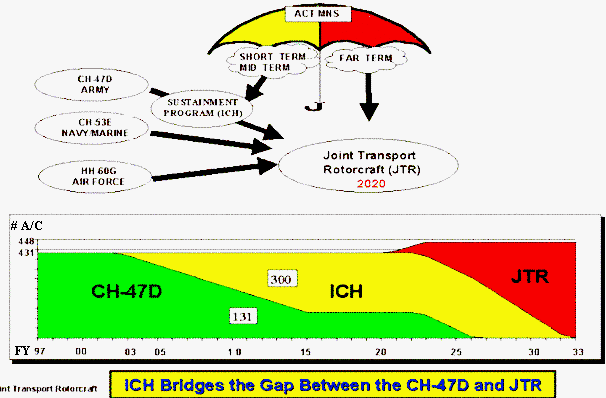
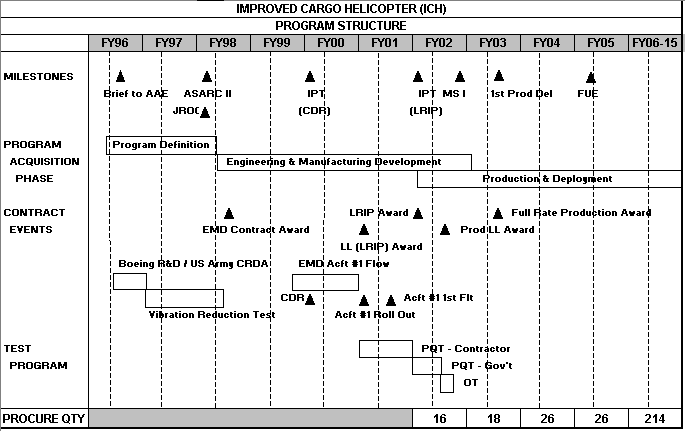
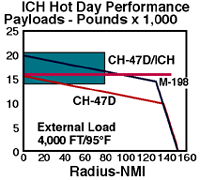 Separate programmatically from the ICH program, the 714 engine program is an Engineering Change Proposal (ECP) to convert the present T-55-712 engines to a T-55-714 engine. This buys back performance on high/hot days lost over time by the addition of weight through modification work order enhancements. Specifically, it will provide an increased lift capability allowing the CH-47 to transport 16,000 pounds for an unrefueled combat radius of 50 nautical miles at 4,000 feet PA and 95 degrees F. The ICH Operational Requirements Document (ORD) requires the CH-47F(ICH) to carry 16,000lbs at 4000ft/95� for a 50nm combat radius (50nm with load, return empty). The CH-47D -714A engine program achieves this requirement. The -714A engine program converts current CH-47D -712 engines to -714A engines. The engine program converts the engines on all 431 CH-47D aircraft. The -714A engine begins fielding in FY99 and, because of recent budget cuts, completes in FY09. 160th (Hunter), 101st, 18th AB Corps, Korea, and Germany are scheduled to be fielded through FY05. The -714A budget constantly fluctuates because of plus-ups and decrements. For this reason, the fielding dates may change.
Separate programmatically from the ICH program, the 714 engine program is an Engineering Change Proposal (ECP) to convert the present T-55-712 engines to a T-55-714 engine. This buys back performance on high/hot days lost over time by the addition of weight through modification work order enhancements. Specifically, it will provide an increased lift capability allowing the CH-47 to transport 16,000 pounds for an unrefueled combat radius of 50 nautical miles at 4,000 feet PA and 95 degrees F. The ICH Operational Requirements Document (ORD) requires the CH-47F(ICH) to carry 16,000lbs at 4000ft/95� for a 50nm combat radius (50nm with load, return empty). The CH-47D -714A engine program achieves this requirement. The -714A engine program converts current CH-47D -712 engines to -714A engines. The engine program converts the engines on all 431 CH-47D aircraft. The -714A engine begins fielding in FY99 and, because of recent budget cuts, completes in FY09. 160th (Hunter), 101st, 18th AB Corps, Korea, and Germany are scheduled to be fielded through FY05. The -714A budget constantly fluctuates because of plus-ups and decrements. For this reason, the fielding dates may change.
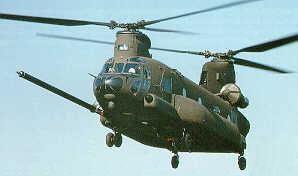 The MH-47E Special Operations Aircraft (SOA) is a derivative of the Boeing CH-47 Chinook. Included with other modifications is a significantly increased fuel capacity with modified main and auxiliary fuel tanks. The aircraft has modified integrated avionics suites and multi-mode radars and is intended to provide adverse-weather infiltration/exfiltration and support to US Military Forces, country teams, other agencies and special activities. The CH-47D Chinook has been specially modified to perform the special operations mission and has been tested in combat. The three versions of the CH-47 in the Army inventory are the CH-47D, the MH-47D, and the MH-47E. The MH-47D and the MH-47E are air refuelable. It provides long-range penetration, medium assault helicopter support to special operations forces. Depending on the version, it can be ferried 1,100 to 2,000 nautical miles unrefueled. During Operation Just Cause, CH-47s conducted H-hour assaults to support other elements who were air-landing SOF to disrupt enemy responses and seize key facilities. During Operation Desert Storm, the CH-47 conducted infiltration and exfiltration of SOF and CSAR of downed pilots. MH-47E testing was limited to the major change to the aircraft which affects vulnerability. In the case of the MH-47E, this was the addition of an 800 gallon Robertson Auxiliary Fuel Tank in the cabin and Boeing designed sponson tanks with expanded capacity and honeycomb shell construction. Analyses conducted during the test planning phase revealed that the largest potential vulnerability was associated with projectiles entering the fuel tanks in the volume above the liquid fuel. Such impacts could ignite the fuel vapors and cause explosions and/or fires with serious consequences. During test planning, USSOCOM decided to add an inerting system to the fuel tanks to avoid such fires/explosions. This will be a lead-the-fleet system that will be available for similar helicopter variants in other fleets as well.
The MH-47E Special Operations Aircraft (SOA) is a derivative of the Boeing CH-47 Chinook. Included with other modifications is a significantly increased fuel capacity with modified main and auxiliary fuel tanks. The aircraft has modified integrated avionics suites and multi-mode radars and is intended to provide adverse-weather infiltration/exfiltration and support to US Military Forces, country teams, other agencies and special activities. The CH-47D Chinook has been specially modified to perform the special operations mission and has been tested in combat. The three versions of the CH-47 in the Army inventory are the CH-47D, the MH-47D, and the MH-47E. The MH-47D and the MH-47E are air refuelable. It provides long-range penetration, medium assault helicopter support to special operations forces. Depending on the version, it can be ferried 1,100 to 2,000 nautical miles unrefueled. During Operation Just Cause, CH-47s conducted H-hour assaults to support other elements who were air-landing SOF to disrupt enemy responses and seize key facilities. During Operation Desert Storm, the CH-47 conducted infiltration and exfiltration of SOF and CSAR of downed pilots. MH-47E testing was limited to the major change to the aircraft which affects vulnerability. In the case of the MH-47E, this was the addition of an 800 gallon Robertson Auxiliary Fuel Tank in the cabin and Boeing designed sponson tanks with expanded capacity and honeycomb shell construction. Analyses conducted during the test planning phase revealed that the largest potential vulnerability was associated with projectiles entering the fuel tanks in the volume above the liquid fuel. Such impacts could ignite the fuel vapors and cause explosions and/or fires with serious consequences. During test planning, USSOCOM decided to add an inerting system to the fuel tanks to avoid such fires/explosions. This will be a lead-the-fleet system that will be available for similar helicopter variants in other fleets as well.
Specifications
|
|
Powerplant: |
Two Textron Lycoming T55-L712 engines
|
|
Rotor System: |
Three blades per hub (two hubs)
Fiberglass construction
Speed: 225 r/min
Manual folding blades
|
|
Performance at 50,000 lb: |
| SL cruise: |
143 kn. |
| Rate of climb: |
1,522 ft/min. |
| Range: |
SL and ISA, 230 nmi. |
|
|
Crew: |
| Cockpit-crew seats: |
2 |
| Cabin-troop seats/litters: |
33/24 |
|
|
Weights: |
| Max gross: |
50,000 lbs. |
| Empty: |
23,401 lbs. |
|
|
Costs | 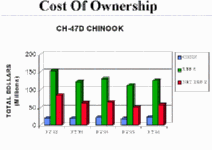 |
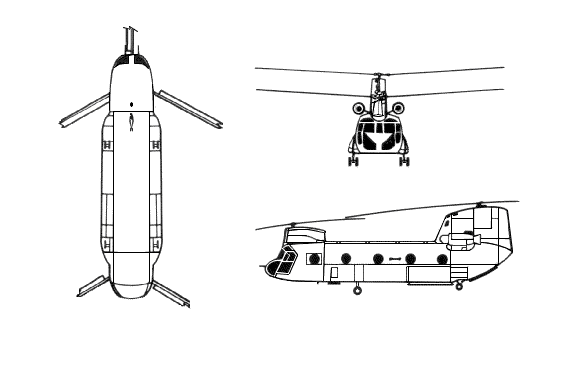
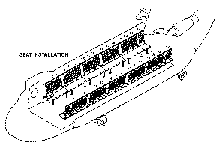
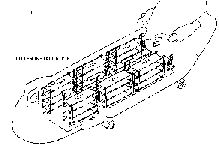

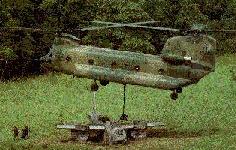
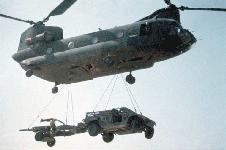
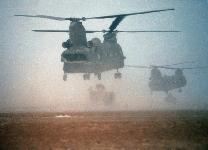
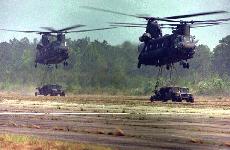

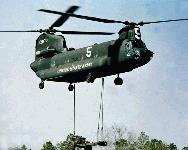
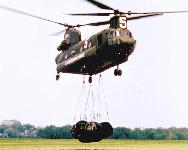
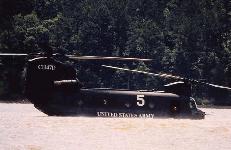


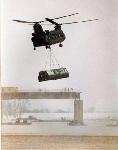
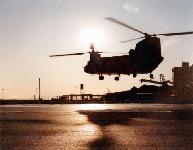
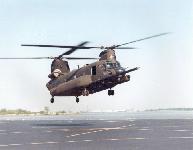
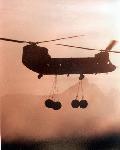
Sources and Resources
http://www.fas.org/man/dod-101/sys/ac/h-47.htm
Maintained by Robert Sherman
Originally created by John Pike
Updated Friday, November 19, 1999 9:14:12 AM







 Separate programmatically from the ICH program, the 714 engine program is an Engineering Change Proposal (ECP) to convert the present T-55-712 engines to a T-55-714 engine. This buys back performance on high/hot days lost over time by the addition of weight through modification work order enhancements. Specifically, it will provide an increased lift capability allowing the CH-47 to transport 16,000 pounds for an unrefueled combat radius of 50 nautical miles at 4,000 feet PA and 95 degrees F. The ICH Operational Requirements Document (ORD) requires the CH-47F(ICH) to carry 16,000lbs at 4000ft/95� for a 50nm combat radius (50nm with load, return empty). The CH-47D -714A engine program achieves this requirement. The -714A engine program converts current CH-47D -712 engines to -714A engines. The engine program converts the engines on all 431 CH-47D aircraft. The -714A engine begins fielding in FY99 and, because of recent budget cuts, completes in FY09. 160th (Hunter), 101st, 18th AB Corps, Korea, and Germany are scheduled to be fielded through FY05. The -714A budget constantly fluctuates because of plus-ups and decrements. For this reason, the fielding dates may change.
Separate programmatically from the ICH program, the 714 engine program is an Engineering Change Proposal (ECP) to convert the present T-55-712 engines to a T-55-714 engine. This buys back performance on high/hot days lost over time by the addition of weight through modification work order enhancements. Specifically, it will provide an increased lift capability allowing the CH-47 to transport 16,000 pounds for an unrefueled combat radius of 50 nautical miles at 4,000 feet PA and 95 degrees F. The ICH Operational Requirements Document (ORD) requires the CH-47F(ICH) to carry 16,000lbs at 4000ft/95� for a 50nm combat radius (50nm with load, return empty). The CH-47D -714A engine program achieves this requirement. The -714A engine program converts current CH-47D -712 engines to -714A engines. The engine program converts the engines on all 431 CH-47D aircraft. The -714A engine begins fielding in FY99 and, because of recent budget cuts, completes in FY09. 160th (Hunter), 101st, 18th AB Corps, Korea, and Germany are scheduled to be fielded through FY05. The -714A budget constantly fluctuates because of plus-ups and decrements. For this reason, the fielding dates may change.
 The MH-47E Special Operations Aircraft (SOA) is a derivative of the Boeing CH-47 Chinook. Included with other modifications is a significantly increased fuel capacity with modified main and auxiliary fuel tanks. The aircraft has modified integrated avionics suites and multi-mode radars and is intended to provide adverse-weather infiltration/exfiltration and support to US Military Forces, country teams, other agencies and special activities. The CH-47D Chinook has been specially modified to perform the special operations mission and has been tested in combat. The three versions of the CH-47 in the Army inventory are the CH-47D, the MH-47D, and the MH-47E. The MH-47D and the MH-47E are air refuelable. It provides long-range penetration, medium assault helicopter support to special operations forces. Depending on the version, it can be ferried 1,100 to 2,000 nautical miles unrefueled. During Operation Just Cause, CH-47s conducted H-hour assaults to support other elements who were air-landing SOF to disrupt enemy responses and seize key facilities. During Operation Desert Storm, the CH-47 conducted infiltration and exfiltration of SOF and CSAR of downed pilots. MH-47E testing was limited to the major change to the aircraft which affects vulnerability. In the case of the MH-47E, this was the addition of an 800 gallon Robertson Auxiliary Fuel Tank in the cabin and Boeing designed sponson tanks with expanded capacity and honeycomb shell construction. Analyses conducted during the test planning phase revealed that the largest potential vulnerability was associated with projectiles entering the fuel tanks in the volume above the liquid fuel. Such impacts could ignite the fuel vapors and cause explosions and/or fires with serious consequences. During test planning, USSOCOM decided to add an inerting system to the fuel tanks to avoid such fires/explosions. This will be a lead-the-fleet system that will be available for similar helicopter variants in other fleets as well.
The MH-47E Special Operations Aircraft (SOA) is a derivative of the Boeing CH-47 Chinook. Included with other modifications is a significantly increased fuel capacity with modified main and auxiliary fuel tanks. The aircraft has modified integrated avionics suites and multi-mode radars and is intended to provide adverse-weather infiltration/exfiltration and support to US Military Forces, country teams, other agencies and special activities. The CH-47D Chinook has been specially modified to perform the special operations mission and has been tested in combat. The three versions of the CH-47 in the Army inventory are the CH-47D, the MH-47D, and the MH-47E. The MH-47D and the MH-47E are air refuelable. It provides long-range penetration, medium assault helicopter support to special operations forces. Depending on the version, it can be ferried 1,100 to 2,000 nautical miles unrefueled. During Operation Just Cause, CH-47s conducted H-hour assaults to support other elements who were air-landing SOF to disrupt enemy responses and seize key facilities. During Operation Desert Storm, the CH-47 conducted infiltration and exfiltration of SOF and CSAR of downed pilots. MH-47E testing was limited to the major change to the aircraft which affects vulnerability. In the case of the MH-47E, this was the addition of an 800 gallon Robertson Auxiliary Fuel Tank in the cabin and Boeing designed sponson tanks with expanded capacity and honeycomb shell construction. Analyses conducted during the test planning phase revealed that the largest potential vulnerability was associated with projectiles entering the fuel tanks in the volume above the liquid fuel. Such impacts could ignite the fuel vapors and cause explosions and/or fires with serious consequences. During test planning, USSOCOM decided to add an inerting system to the fuel tanks to avoid such fires/explosions. This will be a lead-the-fleet system that will be available for similar helicopter variants in other fleets as well.

















